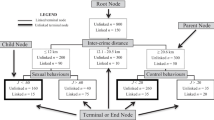Abstract
The present study investigated the possibility of statistically linking arson cases based on consistency of behaviors from one crime scente to another. Serial and spree arson cases were studied to differentiate underlying themes and to link cases committed by the same offender. The material consisted of 248 arson cases which formed 42 series of arsons. A content analysis using 45 dichotomous variables was carried out and principal compnents (PCA) analysis was performed to identify underlying themes. Summary scores reflecting the themes were calculated. Linking effectiveness was tested with a discriminant analysis using the summary scores. The PCA analysis was successful and underlying themes which were in accordance with previous studies could be identified. Six factors were retained, in the PCA. The linking of the arson cases was possible to a satisfactory level: 33% of the cases could be correctly linked and for over 50% of the cases, the series they actually belonged to was among the ten series identified as most probable on the basis of the linking analysis. From a practical point of view, the results could be used as a basis for developing support systems for police investigations of arson.
Similar content being viewed by others
References
Alison, L., Bennell, C., Mokros, A., & Ormeord, D. (2002). The Personality Paradox in Offender Profiling, a theoretical review of the processes involved in deriving background characteristics from crime scene actions.Psychology, Public Policy, and Law, 8, 115–135.
Bennell, C. & Canter, D. V. (2002). Linking commercial burglary by modus operandi; tests using regression and ROC analysis.Science and Justice, 42, 1–12.
Brennan, P. F., & Hays, B. J. (1992). The Kappa statistics for establishing interrater reliability in the secondary analysis of qualitative clinical data.Research in Nursing and Health 15, 153–158.
Canter, D. (1995). Psychology of offender profiling. In R. Bull and D. Carson (eds.)Handbook of psychology in legal contexts. Chichtester England: John Wiley & Sons.
Canter, D. & Fritzon, K. (1998) Differentiating arsonists: A model of fire setting actions and characteristics.Legal and Criminological Psychology, 3, 73–96.
Canter, D. & Gregory, A. (1994). Identifying the residential location of rapists.Journal of the Forensic Science Society, 34, 169–175.
Canter, D. & Heritage, R. (1990). A multivariate model of sexual offence behavior: Developments in offender profiling' I.The Journal of Forensic Psychiatry 1, 185–212.
Canter, D. & Larkin, P. (1993). The Environmental range of serial rapists.Journal of Environmental Psychology, 13, 63–69.
Cohen, J. (1960). A coefficient of agreement for nominal scales.Educational and Psychological Measurement, 20, 37–46.
Comish, D. B. & Clarke, R. V. G. (eds) (1986).The reasoning criminal: Rational, choice perspectives on offending. New York: Springer Verlag.
Douglas, J. E., Burgess, A. W., Burgess, A. G., & Ressler, R. K. (1992).Crime classification manual New York, NY, US: Lexington Book Macmillan, Inc.
Farrington, D. P. (1989). Self-reported and official offending from adolescence to adulthood. In M. W. Klein (ed.)Cross-national research in self-reported crime and delinquency (pp 399–423). Dordrecht, Netherlands: Kluwer.
Fritzon, K. (2001) An examination of the relationship between distance travelled and motivational aspects of arson.Journal of Environmental Psychology, 21, 45–60.
Fritzon, K., Canter, D. & Wilton, Z. (2001) The application of an action systems model to destructive behaviour: The examples of Arson and Terrorism.Behavioral Sciences and the Law, 19, 657–690.
Harnan, H. H. (1976).Modern factor analysis. Chicago, Illinois: The University of Chicago Press.
Holsti, O. R. (1969).Content analysis for the social sciences: and humanities. Reading, Massachusetts: Addison-Wesley Publishing Company.
Häkkänen H., Puolakka, P., & Santtila P. (in press). Crime scene actions and offender characteristics in arson.
Home Office (1999) Safer Communities: Towards effective arson control. The Report of the Arson Scoping Study.
Jackson, H.F. (1994). Assessment of Firesetters. In M. McMurran and J. Hodge (eds.)Assessment of criminal behaviours of clients in secure settings, pp. 94–126. Jessica Kingsley: London.
Jackson, H.F., Glass, C. & Hope, S. (1987), A functional analysis of recidivistic arson.British Journal of Clinical Psychology, 26, 175–185.
Krippendorf, K. (1980).Content analysis: An introduction to its methodology. Beverly Hills, CA: Sage.
MacCulloch, M.J., Snowden, P.R., Wood P.J.W. & Mills, H. E. (1983) Sadistic fantasy, sadistie behaviour and offending.Britisch Journal of Psychiatry, 143, 20–29.
McClelland, D.C. (1980). Is Personality Consistent? In A.I. Rabin, J. Arnoff, A.M. Barclay and R.A. Zucker (Eds.)Further explorations in personality. New York: Wiley.
Miller, S. and Fritzon, K. Functional consistency across two behavioural modalities: Firesetting and self harm in female, special hospital patients Submitted toCriminal Behaviour and Mental Health.
Pervin, L.A. (1989).Personality Theory and research. J. Wiley & Sons.
Pulkkinen, L. (1983). The search for alternatives to aggression. In A.P. Goldstein and M.H. Segal, (eds)Aggression in Global perspectives (pp. 104–144). New York: Pergamon Press.
Santtila, P., Häkkänen, H. & Fritzon, K. (2003). Inferring the characteristics of an arsonist from crime scene behaviour: a case study in offender profiling.International Journal of Police Science and Management, 5(1) 1–15.
Sapp, A.D., Huff, T. G., Gary G. P., Icove, D.J. & Horbert, P. (1994). A report of essential findings from a study of serial arsonists. Quantico, Virginia. National Centre for the Analysis of Violent Crime, FBI Academy.
Shye, S. (1985). Nonmetric multivariate models for behavioral, action, systems. In D. Canter (Ed.)Facet, theory Approaches to social research pp 97–148). New York: Springer Verlag.
Shye, S., Elizur, D., & Hoffman, M. (1994).Introduction to facet theory: Content design and intrensite data analysis in behavioural research. London, Sage Publications.
Tabachnick, B. G. & Fidell, L.S. (2001).Using multivariate statistics. New York: Allyn and Bacon.
Author information
Authors and Affiliations
Corresponding author
Additional information
This research was financially supported by the Finnish Ministry of Interior and by Grant 54456 from the Academy of Finland.
Rights and permissions
About this article
Cite this article
Santtila, P., Fritzon, K. & Tamelander, A.L. Linking arson incidents on the basis of crime scene behavior. J Police Crim Psych 19, 1–16 (2004). https://doi.org/10.1007/BF02802570
Issue Date:
DOI: https://doi.org/10.1007/BF02802570




